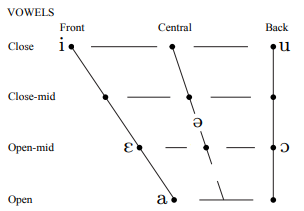Sani language
The Sani language, xele sani, formerly called Lakhesian by the colonial power Shireroth, is a Cosimo-Benacian language spoken by approximately 35 million people in Sanama and Talenore. It is closely related to Ama with which it has extensive mutual intelligibility. Around 30 million speakers can be found in Sanama, and 5 million in Talenore. It is an official language in Talenore and the main official language in Sanama. Sani is an analytic language with a large number of particles.
Official status
Sani is an official language in Sanama and an official language in Talenore.
Distribution and usage
Sani is spoken natively in central, southern and southeastern Sanama, in the area traditionally called Sanilla. It has its strongest position outside the large cities. In rural areas and smaller cities and towns, it is by far the majority language. In larger cities, like Niyi, it has a much weaker position, usually in favor of Istvani. In the entire country of Sanama, almost half of all people have Sani as their mother tongue, making it the plurality language.
Phonology
Consonants
| Bilabial | Labiodental | Dental | Alveolar | Post-alveolar | Palatal | Velar | Uvular | Glottal | |
|---|---|---|---|---|---|---|---|---|---|
| Plosive | p | t | k | q | |||||
| Nasal | m | n | ŋ | ||||||
| Trill | r̥ r | ||||||||
| Fricative | f | θ | s | ʃ | x | h | |||
| Approximant | ʍ w | j | |||||||
| Lateral approximant | l̥ l |
Where consonants appear in pairs, the left is unvoiced and the right is voiced.
Vowels
Sani has six vowel phonemes. They do not contrast for length or nasality. The Sani schwa vowel is transliterated as Ë, while the E vowel varies between /e/ and /ɛ/ depending on environment.
Phonotactics
Orthography
| Orthography | A | E | Ë | F | Ff | H | I | K | L | Ll | M | N | Ng | O | P | Q | R | Rr | S | T | U | W | Wh | X | Y | Sh |
|---|---|---|---|---|---|---|---|---|---|---|---|---|---|---|---|---|---|---|---|---|---|---|---|---|---|---|
| Phonology | a | ɛ-e | ə | f | θ | h | i | k | l | l̥ | m | n | ŋ | ɔ | p | q | r | r̥ | s | t | u | w | ʍ | x | j | ʃ |
Grammar
Syntax
Sani is a subject-verb-object language. The role a word plays in a sentence is derived from its position as well as any modifying particles or words. Sani can therefor be said to be an analytic language.
Sani vocabulary
Most of the Sani vocabulary is Cosimo-Benacian in origin, but the language has also borrowed words, mostly from Cisamarrese, and more recently Istvanistani, Praeta and Babkhi.
| Semantic Domain | Word | Etymology | Definition |
|---|---|---|---|
| body | xonu | noun: head, main | |
| government | xonuti | noun: king, leader, chieftain | |
| grammar | ti | modifier: abstraction of noun to refer to a person | |
| grammar | lla | modifier: area belonging to the modified noun | |
| zawa | adjective: free, unchained, not in servitude, independent | ||
| government | rrumë | noun: state, independent entity | |
| grammar | na | conjunction: and | |
| government | kosos | Pr. Koïsoß, "Empire or a significant State, realm, domain, sphere" | noun: empire |
| interjection | oyá | interj.: hello, hi | |
| color | lunti | noun, adjective: green | |
| structure | ffaman | noun: garden, fenced or otherwise delimited area with controlled greenery | |
| direction | esa | noun, adjective: east | |
| geology | paharr | noun: spring, source of running water | |
| direction | ate | noun, adjective: west | |
| geography | hareffa | noun: island | |
| geography | hareffina | Sa. hareffa, island + ina, half | noun: peninsula |
| colloquialism | tata | noun: filth, dirt | |
| profanity | tati | Sa. tata, filth, dirt | noun: originally a derogatory term for Sanis used by Istvani-speakers in and around Niyi. Now considered a racist slur, but used to that effect all over the country in certain circles. |
| abstract | pesh | adjective, noun: dead, death | |
| government | whëna | noun: council, assembly | |
| geography | ranti | noun: beach, shore | |
| direction | teta | noun, adjective: south | |
| geography | puri | noun: harbour, port | |
| geography | kara | noun: river | |
| axi | adjective: new |
